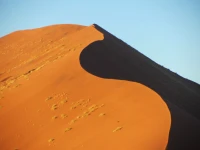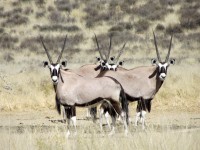Before this latest trip to Namibia, I had not been there for many years. My impressions of the country and its people were through the eyes of a child. Back then my family did a long road trip through Namibia, and I can remember the insane distances we were driving and the intense heat (it was mid-summer). And the sand and rocks everywhere. I did have fond memories of the trip though – it was just so different from everything I knew.
Willie and I visited Namibia in mid-winter which made the whole trip more bearable. But the insane distances and rocks and sand were still there. So what impressed us about Namibia?
The Scenery
From the moment you cross the border the scenery starts changing. I had wanted to document our whole Namibian experience and started to whip out my camera at the border post, when Willie pointed out that may not be a smart move. The border police might find that a little suspicious. So I had to contain my excitement until we had been through border control and driven a little way into Namibia.

First photo after driving through the South African-Namibian border at Vioolsdrift. ©LB/notesfromafrica.wordpress.com

First Kokerboom (Quiver Tree) photo (there were many to follow!) on entering Nambia. ©WMB/notesfromafrica.wordpress.com
Besides the really iconic landscape and landmarks like the Fish River Canyon and Soussousvlei, almost every vista showed an amazing rock formation or desert scene. We stopped numerous times just to stare in wonder and take photographs.

Edge of the Fish River Canyon in the late afternoon. ©WMB/notesfromafrica.wordpress.com

One of the huge red dunes at Sossousvlei – you can see the size of the dune compared to the tree at the base, as well as the tiny people climbing the dune. ©LB/notesfromafrica.wordpress.com
The People
Namibians are friendly and intensely proud of their country. Speaking to the locals you almost got a sense that they could not understand why you would want to live elsewhere. They are also very good hosts – they welcome visitors to their country and want to show off their country. We met a lot of especially European tourists (mainly Italians and French visitors) on our travels there.

Early morning hot balloon ride in the desert. ©LB/notesfromafrica.wordpress.com

Interesting rock ledge formation – and a convenient toilet – in the middle of nowhere. ©LB/notesfromafrica.wordpress.com
The Infrastructure
The travelling distances in Namibia are enormous. In 2 weeks we travelled 7643 kilometres, and we didn’t even cross the country from south to north, west to east. However, the roads are very good – even the numerous dirt roads one has to travel to get to specific landmarks. The dirt roads were really well maintained and very wide – almost like runways.
Namibia is a great place for tourists to visit. There are a lot of lodges, car hire companies and tourist guides.
We were impressed by the fact that in a lot of places we stayed, free WiFi (or “Wiffie” as the locals called it) was available to guests. Something we hadn’t experienced in South Africa at that stage – where at the time one paid for a WiFi connection in hotels and lodges.

Tirasberg grasslands ©WMB/notesfromafrica.wordpress.com
The Wildlife Conservancies
Namibia is one of few countries in the world to specifically address habitat conservation and protection of natural resources in their constitution. Article 95 states, “The State shall actively promote and maintain the welfare of the people by adopting international policies aimed at the following: maintenance of ecosystems, essential ecological processes, and biological diversity of Namibia, and utilization of living natural resources on a sustainable basis for the benefit of all Namibians, both present and future.” – Wikipedia
Through the above legislation local communities have been able to “create conservancies that managed and benefited from wildlife on communal land while allowing the local community to work with private companies to create and manage their own tourism market.” (Wikipedia article). The Wikipedia article is an excellent introduction to the conservation issues faced in Namibia, and the role of the Wildlife Conservancies.
This is such a brilliant idea. Not only does it help conservation efforts, it provides much needed income and job opportunities for the local communities. So it gives value to conservation and gets the local communities invested in maintaining those natural resources and ecosystems.
We came across several of these conservancies in our travels. At Twyfelfontein the local community manages a site which has unique rock carvings which we done by their own ancestors. They operate everything from the information centre and kiosk, to having guides from the community take visitors to the site and give lectures about the rock carvings and the history of the area.

Twyfelfontein Kiosk area ©LB/notesfromafrica.wordpress.com

Twyfelfontein visitors centre ©LB/notesfromafrica.wordpress.com
At Spitzkoppe we stayed in a camp which was run by the local community.

Community run camp at the base of Spitzkoppe ©LB/notesfromafrica.wordpress.com

Community run camp at the base of Spitzkoppe. ©WMB/notesfromafrica.wordpress.com
In the Tirasberg area, four farms “teamed up to form the Tirasberg Conservancy which covers 125 square kilometres. The Conservancy protects, ecologically manages and aims to make the beautiful Tiras Mountains area accessible to tourists.” (Tracks4Africa) This area had some unique rock formations. With the permission of one of the farmers, one can drive through the area and look at the landscape and the wild animals (mostly antelope) roaming across it.

Gemsbok in the Tirasberg Conservancy ©WMB/notesfromafrica.wordpress.com

Interesting rock formations in the Tirasberg Conservancy. ©LB/notesfromafrica.wordpress.com

Huge boulder in the Tirasberg Conservancy ©LB/notesfromafrica.wordpress.com
The Etosha National Park
This is in the northwestern Namibia and “spans an area of 22,270 square kilometres (8,600 sq mi) and gets its name from the large Etosha pan which is almost entirely within the park. The Etosha pan (4,760 square kilometres (1,840 sq mi)) covers 23% of the area of the total area of the Etosha National Park. The park is home to hundreds of species of mammals, birds and reptiles, including several threatened and endangered species such as the black rhinoceros.” (Wikipedia article) It is a stunning place to visit and a huge tourist attraction.
In future posts I’ll be discussing all of the places mentioned here in more detail. But I think you can see from these highlights that Namibia is definitely worth a visit!
This post is part of a series I will be publishing about our travels through Namibia. It is also part of my daily posts for October 2016 – otherwise known as The October Dash


















In one word, SPECTACULAR!
It is a stunning place, isn’t it? 🙂
Most certainly!
Namibia sounds very intriguing! It’s quite impressive that the government manages to maintain the condition of the roads in the sparsely-populated country. Namibia along with Botswana seem to be doing well compared to most countries in the continent.
Obviously I’m only observing Namibia as a tourist, but Namibia does seem quite stable in comparison to other African countries. As we were driving we listened to the local radio stations. The news was very much like the South African news: crime, corruption, gender violence. Where I think Namibia excels is involving local communities in the tourist industry (one of Namibia’s main sources of income). I guess that maintaining a good road infrastructure is part of making the country accessible to tourists.
What a fabulous post, Lisa. You’ve neatly encapsulated all the reasons for visiting Namibia – if possible, repeatedly! And you’ve definitely whet my appetite to plan another trip.
The driving distances are so vast that you are bound to see and experience something different each time you visit. We also found the gravel roads to be, on the whole, very well-maintained, making for pleasant – if somewhat dusty and rattly – driving; their graders clearly have a lot of work to do all around the year, to keep the roads free from corrugations and to repair roads after flash floods.
I didn’t know about the conservancies – I’ve heard that there are a couple in the country, but didn’t know what it really meant. What an excellent idea – to empower the local community, provide employment, protect the environment, foster pride in their local customs and history, educate visitors, involve the community in looking after their own environment etc.
BTW, I laughed out loud when I read the bit about wanting to whip out your camera at the border post! I can totally relate to that, Lisa! Every time we’ve crossed the border, my fingers have itched to take some photos – but the only bit where I feel alright about doing so is when you drive over the Orange River, because, well, it’s the Orange River and you just *have to* take pics. 😉
A couple of years ago, the South African border post at Vioolsdrif was completely revamped; it looks *amazing* now, so modern and neat and clean, and professional; I remember when it was just a couple of swelteringly hot prefab buildings. The Namibian border post has been under renovation for a while now, and the last time we crossed over around April it was still a messy building site. I am longing for the work to be finished, because it’s so unpleasant and dirty and there are always endless queues and not enough of those little forms you have to fill in – it’s not a good impression of a spectacularly beautiful and vast country.
Thanks for your lovely response! 🙂 I was hoping that you would like the post.
Any roads that are better than the roads in the Kgalagadi are good! 😉 You really haven’t experienced corrugated roads until you’ve been there!
When we passed through the border they were still in the process of building the new border post. The layout of the offices one had to visit, and thus the sequence of the process, wasn’t too intuitive. But it did make you feel like you were leaving one country and entering another – if the process is too seamless this feels less obvious.
I also visited Namibia in 2012 and loved it. Dying to go back!
There are so many places we never got to see – some of the places you wrote about on your blog. Will definitely be going back as well.
We also missed so much. You’d have to go for at least a month to hit all the top places even briefly.
*smile* I feel ‘old’ suddenly: this part of the world was known as German SW Africa when I was born . . . so fascinating to see what it really looks like now . . . very dramatic but very neat at points of habitation . . .
We didn’t visit many of the towns or cities – at least not anything more than refuelling and going on our way. So we don’t have any photos of how where the Namibians live and work.
This is just fascinating to someone who has never been in Africa, and I would love to visit. Not sure my budget will allow that kind of travel these days, though.
Out of curiousity, do you know if tourism increased after the filming of Fury Road? The Namibian countryside played such a big part in that.
Hi there! 🙂 I have no idea of the effect of Fury Road, but it would be interesting to know. We were there in 2013 – so before the movie was released, but after it was filmed. Most of the foreign visitors we met while we were there (and there were already a lot of them) were from Europe. Maybe that changed after the movie was released?
Well, now I am well and truly hooked! Someone in the tourism industry should be paying you for your superb photos and information – your posts certainly inspire me to want to come and spend time soaking it all in.
Yes! I would become a paid “travel blogger” if I travelled more. For the time being I’m just happy if people enjoy my posts and it inspires them to travel to the places I love.